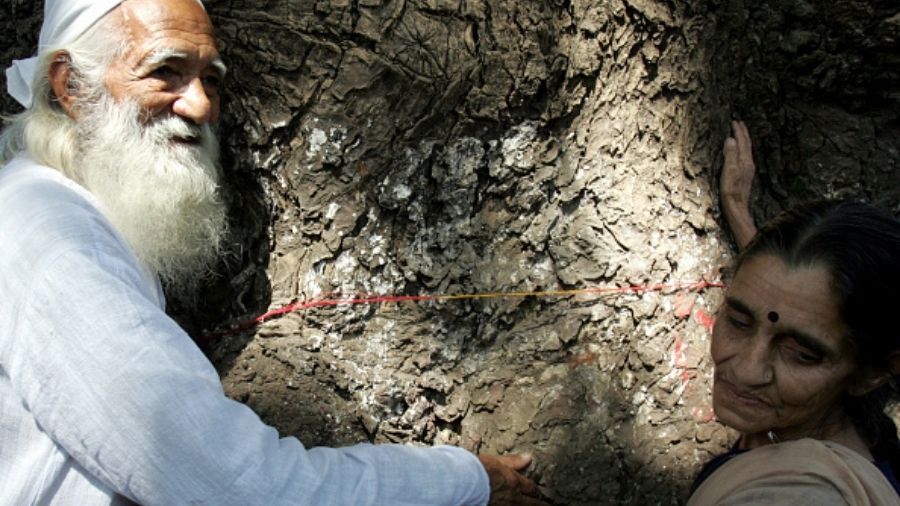-
Sundarlal Bahuguna,‘Gentle Warrior’: “Himalaya is a land of penance. Nothing in the world can be achieved without penance. I am doing this on behalf of all who are striving to save our dying planet. Why should a river, a mountain and forest or the ocean be killed, while we cling to life?”.
As late as 2018, when Bahuguna was 91, he said in an interview that dams were paving the way for calamities and expressed concern that lakhs of trees will be cut down to make way for the Char Dham road and Pancheshwar dam. “The well-being of the Himalayas is important not just for Uttarakhand but the rest of the country as well”. - Protection wanes by 6 months: Efficacy of Chinese vaccines is “not high” — officials back 3rd dose
- Only Allopathy gets benefit of doubt? AP govt stops distribution of herbal Covid cure. . . . No side effects, say Ayurvedic experts. ‘The mixture, containing 18 ingredients, is safe for administration to COVID-19 patients’
- More of East India loot? India challenges $1.2 billion Cairn arbitration award, says 'never agreed to arbitrate'.. When an Air India aircraft lands at any US airport, Cairn would be able to move court and get that attached before it flies out.
- Mango exports: US apples arrived in India without the Indian inspector being in the USA, but vice versa was not allowed. No Indian mangoes in US for second year in a row.
-
What are weeds? An empty field left undisturbed for long enough will inevitably turn into a forest, given enough time. Nature will fill empty, barren or disturbed ground with plants which quickly stabilise and build the soil, to prepare the ground for progressively larger plants, until the area is filled with trees, and many layers of understory plants beneath them. This process is called Forest Succession.
Why forests? Because forest systems are one of the most productive and most sustainable systems known, it is what Nature creates at almost every opportunity. Forest systems can be designed to produce food if we construct them using edible plant species, and they can produce other useful resources such as timber, fibres, dyes and medicines. In addition, what makes them special is that they are living ecosystems, and therefore support great biodiversity, they provide a home to a wide range of flora and fauna, which all comes together to create a balanced, natural, pest and weed free system.
When any soil is laid bare or disturbed, Nature has a system for repairing the degraded ground in order to prevent soil erosion and to reconstruct the ecosystem which was there or should be there. As the first line of action, Nature deploys pioneer plants, to stabilise the soil. These plants all have various unique attributes and aid the reconstruction process in various ways. Here are some examples:
- Plants with deep tap roots drill into hardpan to decompact it, creating channels to allow water and air back in the soil.
- Plants with fine, net-like root structures hold the soil together and prevent erosion on slopes and banks.
- Plants with thorns or which are poisonous protect the ground cover plants from being over-grazed by herbivores.
We are all familiar with these amazing pioneer plants, we commonly call them weeds! Weeds are by definition “plants growing where we don’t want them to” and that is not a biological or ecological categorisation, it’s just a unscientific value judgement of the worth and place of certain plants in the ecosystem according to subjective human opinion. The pioneer plant’s action of stabilising any soil disturbance or damage is only the first of many steps of a full-blown reconstruction process which Nature carries out. - Planting the water: Peru is reviving a pre-Incan technology for water. It uses water canals called amunas – to divert wet-season flows from mountain streams and route them to natural infiltration basins. Because the water moves more slowly underground as it travels through gravel and soil, it emerges downslope from springs months later, when the comuneros collect it to water their crops. Because much of their irrigation soaks into the ground and eventually makes its way back to the rivers, repairing abandoned amunas scattered throughout the highlands could extend water into the dry season for city dwellers too.
- Iran unveils its domestic supercomputer: Wholly designed and built by a team of Iranian engineers, it has a performance capacity of 0.56 petaflops at the moment and will reach one petaflops in two months.
- 2DG: “It is a glucose molecule analogue which can’t undergo further glycolysis. Monocytes/macrophages in Covid lungs (proliferative tissues: inflammation/tumour) become highly glycolytic after infection and facilitate SARS-CoV-2 replication which accumulates in virally infected cells and prevents virus growth by stopping viral synthesis and energy production.. Dr Jain showed that 2-DG can function as a differential radio-chemo-modifier, which can sensitize cancer cells while protecting normal cells. It enhances cellular damage and cell death by inhibiting repair and recovery.”
After Just 1 Hour of Administring Dose ...
— Megh Updates 🚨 (@MeghUpdates) May 24, 2021
Effect of '2-deoxy-D-glucose' of DRDO video of CHL Hospital, Indore.
Great work by our Scientists👍🇮🇳🙏pic.twitter.com/UKVTHhyuaD

No comments:
Post a Comment
Relevant and respectful comments only, please